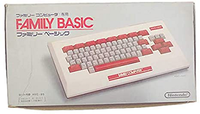From NintendoWiki, your source on Nintendo information. By fans, for fans.
| Family BASIC
|
ファミリーベーシック
ファミリーベーシックV3
|
|
|
|
|
| Japan:
|
June 21, 1984
V3: February 21, 1985
|
|
|
|
|
|
Family Basic is a programming tool and utility/creation software for the Famicom. It was available with the Famicom Data Recorder and Famicom Keyboard.
It is actually the successor to an earlier version of the software called Playbox BASIC; bundled in a cartridge with the My Computer Televi C1 (a television by Sharp with a built-in Famicom also known as the Game Television/Sigma 9400 Chassis in North America[1], Sampo C1 in Taiwan[2] or in general as the Sharp Nintendo Television).
Gameplay
It allows the user to program games in BASIC, specifically in a language called "NS-HUBASIC". In addition to this, there are added minigames with some exclusive to the V3 revision, including Super Mario series characters and the penguin Gurin, from Binary Land.[3] Programs from other media can be loaded from the Famicom Data Recorder (tapes) or typed in manually using the Famicom Keyboard. In addition to the keyboard, games also support the Famicom's built-in microphone.
Furthermore, Family BASIC includes a Message Board for typing messages, a Calculation Board for performing mathematical calculations, and a Music Board for composing music.
Differences with Playbox BASIC
Playbox BASIC features a Biorhythm Board mode instead of the Message Board mode in Family BASIC, because the dedicated television already included that feature.
See also
References

|
This article is a stub. You can help NintendoWiki by expanding it.
|

